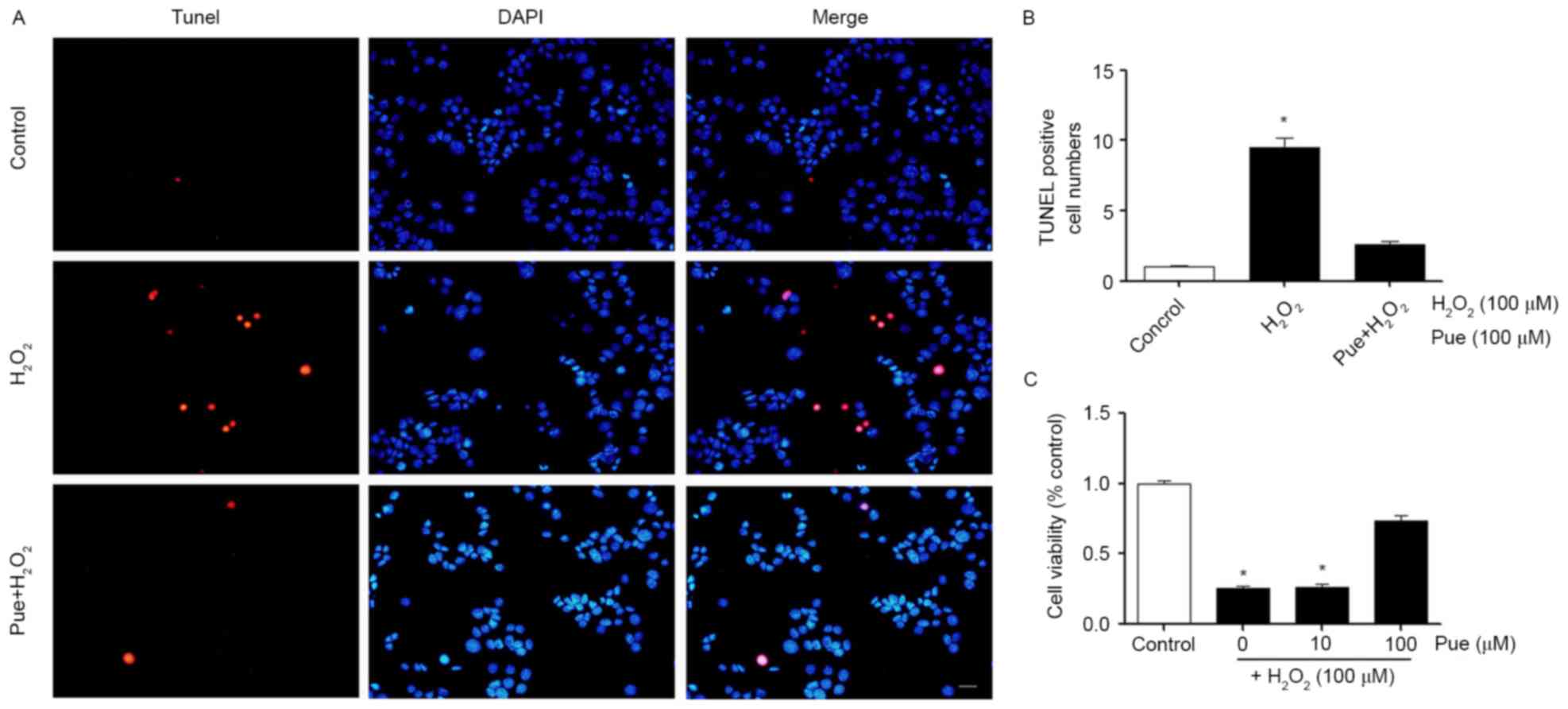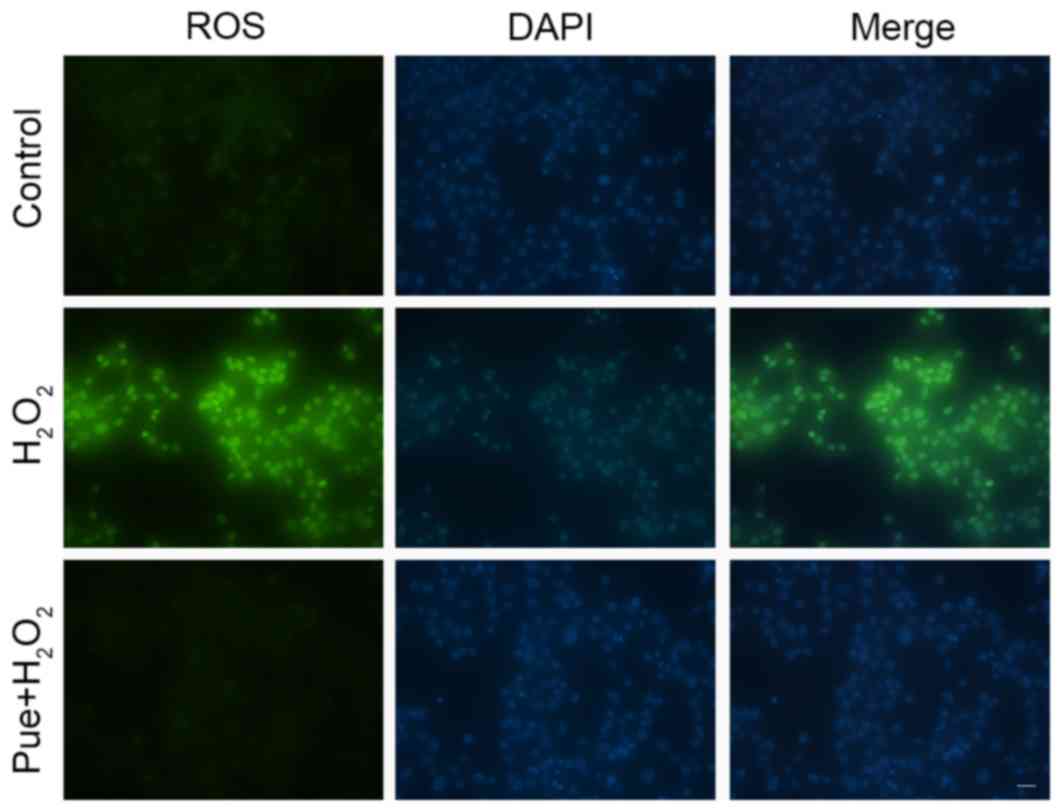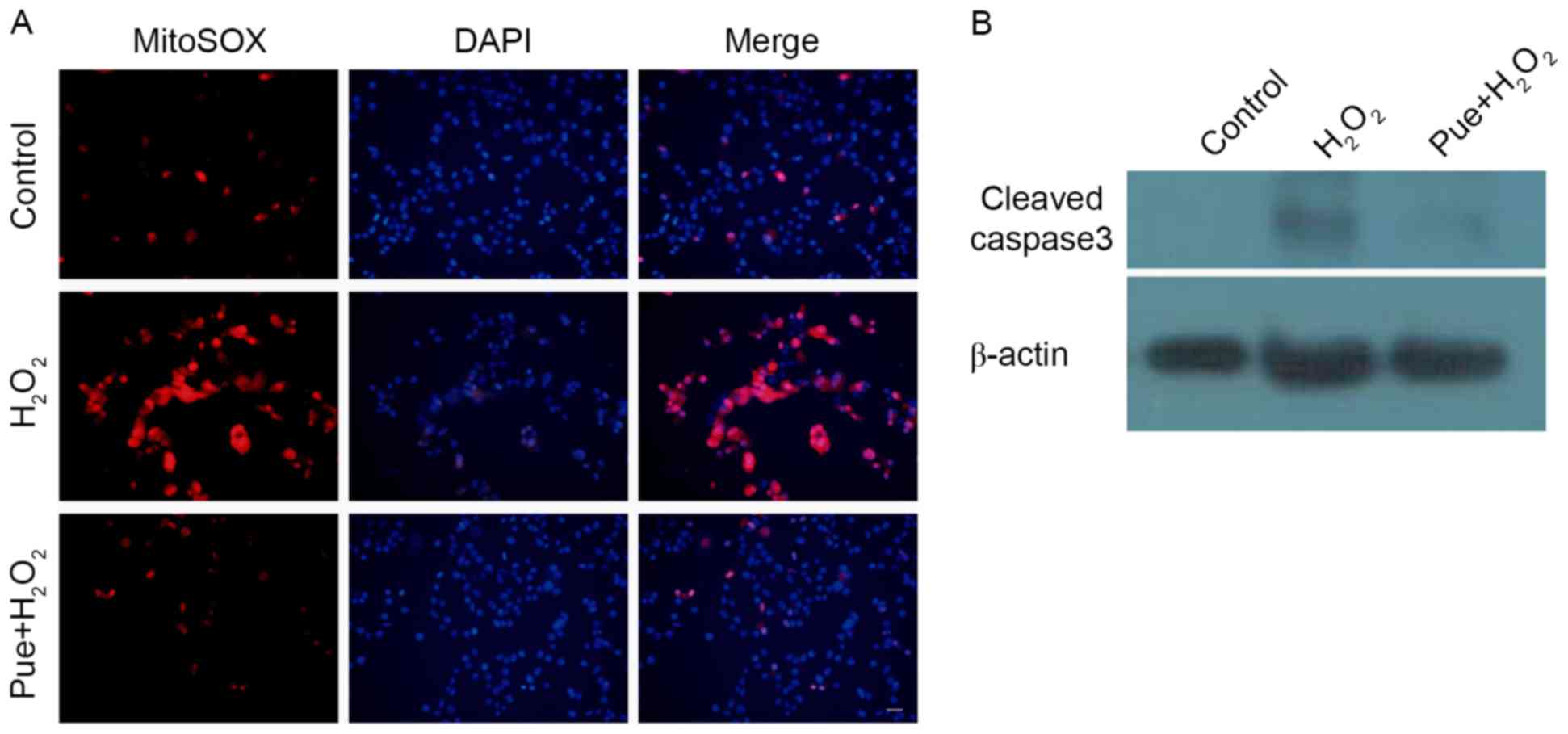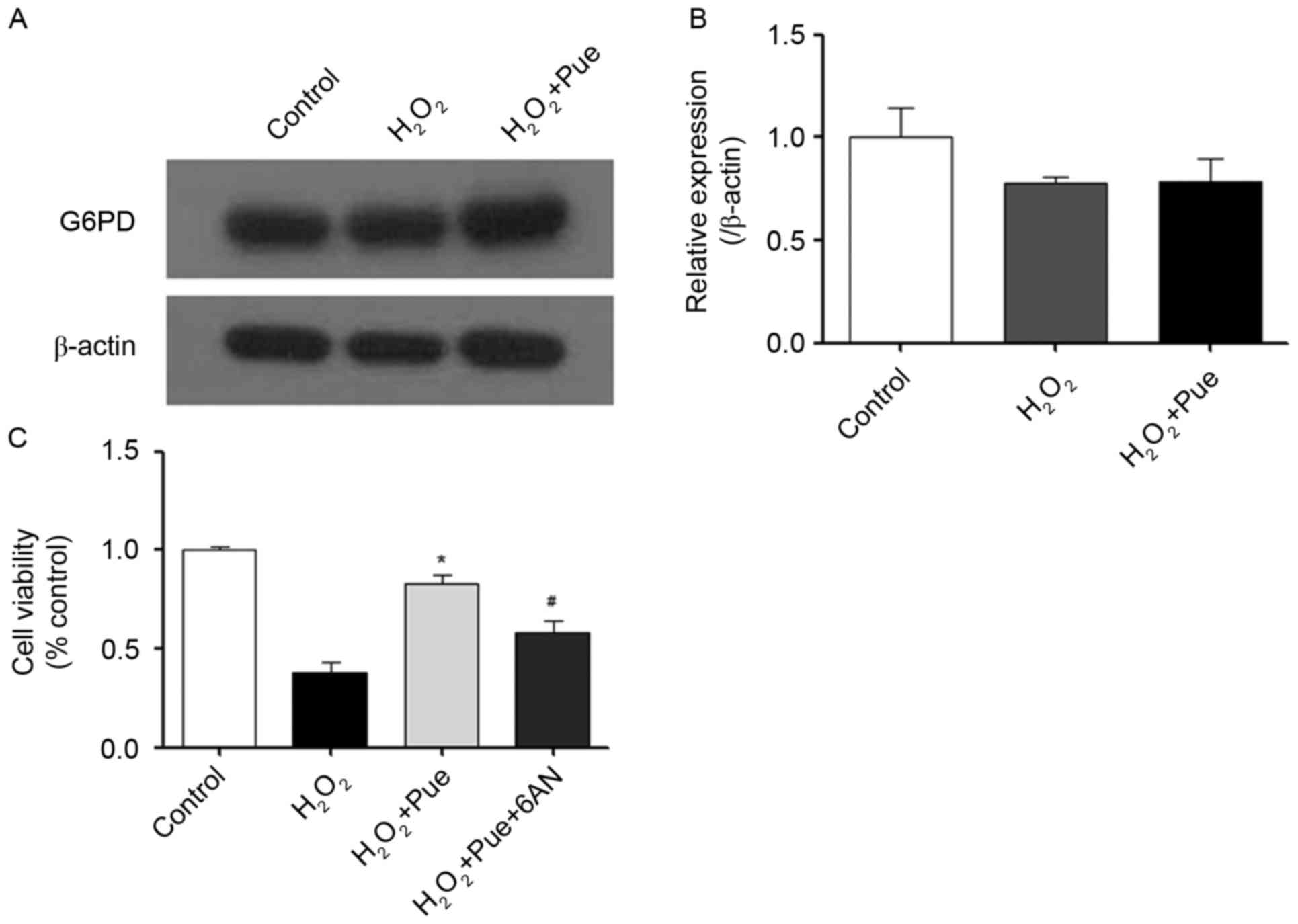Puerarin promotes MIN6 cell survival by reducing cellular reactive oxygen species
- Authors:
- Published online on: March 14, 2018 https://doi.org/10.3892/mmr.2018.8731
- Pages: 7281-7286
Abstract
Introduction
Diabetes is a chronic disease that is common worldwide. According to its pathogenesis, diabetes can be broadly divided into type 1 and type 2 diabetes (1). Type 1 diabetes is caused by the destruction of β-cells, resulting in an inefficient level of insulin secretion, while type 2 diabetes is due to insulin resistance (2). There are a number of potential causes of pancreatic β-cell damage, including hypoxia, oxidative stress, glycosylation end-products and autoimmune reactions (3–6). However, the detailed mechanism underlying pancreatic β-cell injury in diabetes remains unclear. Therefore, the present study aimed to investigate a novel drug which may protect pancreatic β-cells against metabolic stress. Decreasing pancreatic β-cell damage is an essential part of treating type 1 diabetes.
Puerarin is an analogue of estrogen that was first isolated from Pueraria lobata. Previous studies have demonstrated that puerarin effectively decreased blood glucose in rats with type 1 diabetes (7,8). An additional previous study demonstrated that estrogen was able to effectively promote the survival of the transplanted pancreatic β-cells (9–11). Since puerarin is an analogue of estrogen (12–14), and puerarin is able to decrease blood glucose in type 1 diabetic rats and mice (15), it was hypothesized that puerarin may be of benefit in protecting mouse insulinoma MIN6 cells from external stress, while promoting cell survival. However, the detailed mechanism underlying the role of puerarin in diabetes remains unclear. Investigation of the mechanism of puerarin is conducive to the treatment of type I diabetes.
Due to the requirement for pancreatic β-cells to synthesize a large amount of insulin, pancreatic β-cells are frequently exposed to oxidative stress (16,17). Therefore, oxidative stress was considered to be among the primary causes of pancreatic β-cell apoptosis. The present study used H2O2 to induce intracellular oxidative stress, in order to investigate the protective effect of puerarin on MIN6 cells. In H2O2-induced apoptosis experiments, it was observed that puerarin significantly decreased apoptosis, and the levels of intracellular reactive oxygen species (ROS) and mitochondrial superoxide (MitoSOX). It was additionally observed that the ability of puerarin to protect MIN6 cells was decreased by 6-aminonicotinamide (6AN). Puerarin in MIN6 cells may promote the activity of glucose-6-phosphate dehydrogenase (G6PD), thereby reducing intracellular oxidative stress; puerarin may therefore protect against apoptosis induced by H2O2 in pancreatic β-cells.
Materials and methods
Cell culture
MIN6 cells were purchased from ATCC (Manassas, VA, USA) and cultured in a 37°C incubator (Sanyo, Osaka, Japan) containing 5% CO2. MIN6 cells were grown in high glucose Dulbecco's modified Eagle's medium (HyClone; GE Healthcare Life Sciences, Logan, UT, USA) containing 15% fetal bovine serum (HyClone; GE Healthcare Life Sciences), 1% penicillin-streptomycin (HyClone; GE Healthcare Life Sciences) and 0.2% β-mercaptoethanol (Sigma-Aldrich; Merck KGaA, Darmstadt, Germany). The cells were cultured overnight before treatment with puerarin, H2O2 and 6AN. Puerarin, 6AN and H2O2 were purchased from Sigma-Aldrich (Merck KGaA). Briefly, prior to experiments, MIN6 cells (1×104 cells) were seeded in 96-well plates overnight. Then, puerarin (100 µM) was used to pre-treat the cells for 6 h during the experiments. Finally, H2O2 (100 µM) and 6AN (50 µM) were used to treat the cells for 24 h at the same time and cultured in an incubator at 37°C.
Terminal deoxynucleotidyl transferase dUTP nick end labelling (TUNEL) assay and cell viability
The cells were homogeneously seeded in 24-well plates at 2×105 cells per well with slides and cultured. Precooled 0.01 M PBS was used to wash the cells twice. MIN6 cells were fixed with 4% paraformaldehyde for 30 min at room temperature. Cells were subsequently permeabilized in 0.1% Triton-x 100 in 0.01 M PBS. TUNEL (Roche Diagnostics, Indianapolis, IN, USA) staining materials were mixed according to the manufacturer's protocol, and were subsequently added to the fixed cells in the incubator at 37°C for 60 min. The cells were washed three times with 0.01 M PBS. Finally, 0.3 mM DAPI was added for staining of the nuclei at room temperature for 3 min. Each sample was observed in 5 different fields, with a magnification of ×400. The cells were washed three times with 0.01 M PBS. Cell viability was detected using a Cell Counting Kit-8 (CCK-8) assay (Dojindo Molecular Technologies, Inc., Kumamoto, Japan).
Cell ROS and MitoSOX detection
MIN6 cells were cultured in 24-well plates until 90% confluence, the cells were washed with 0.01 M PBS. The corresponding volumes (5 µl) of CellROS (Invitrogen; Thermo Fisher Scientific, Inc., Waltham, MA, USA) and Hoechst (Guangzhou Ribobio Co., Ltd., Guangzhou, China) were added to MIN6 cells at 37°C for 30 min. Subsequently, the cells were washed three times with 0.01 M PBS, observed and photographed under a microscope, with a magnification of ×400. MitoSOX (Invitrogen; Thermo Fisher Scientific, Inc.) and Hoechst were added to 24-well plates at 37°C for 15 min, and cells were washed three further times with 0.01 M PBS, observed and photographed under a microscope, with a magnification of ×400.
Western blotting
MIN6 were cells grown in the 6-well plates and washed by precooled 0.01 M PBS. The cells were lysed with radioimmunprecipitation assay lysis buffer (EMD Millpore, Billerica, MA, USA) and placed on ice for 30 min. Cells in lysis buffer were centrifuged at 15,000 × g and 4°C for 15 min. The supernatant was collected and the concentration of the total protein in the supernatant was measured using a bicinchoninic acid kit (Thermo Fisher Scientific, Inc.). Loading buffer was added to the supernatant and boiled for 10 min. Protein samples (30 µg per lane) were subjected to electrophoresis on a 10% SDS-PAGE gel, at 80 V and constant pressure. The total proteins in the gel were transferred onto polyvinylidene fluoride (PVDF) membranes (EMD Millipore) at 300 mA constant current for 90 min. The PVDF membranes were blocked in 5% non-fat milk (Cell Signaling Technology, Inc., Danvers, MA, USA) for 1 h at room temperature. The primary antibodies against cleaved caspase3 (cat. no. 9664; Cell Signaling Technology, Inc.), β-actin (cat. no. 3700; Cell Signaling Technology, Inc.) and G6PD (cat. no. 12263; Cell Signaling Technology, Inc.) were diluted 1:1,000. All the primary antibodies were incubated at 4°C for 8 h. The secondary antibodies Goat Anti-Rabbit IgG (cat. no. A9169; Sigma-Aldrich; Merck KGaA) and Goat Anti-Mouse IgG (cat. no. A8924; Sigma-Aldrich; Merck KGaA) were diluted 1:10,000. The secondary antibodies (HRP conjugated) were incubated at 25°C for 1 h. Enhanced chemiluminescence liquid (Lulong, Inc., Xiamen, China) was added to the membranes and images were captured. The results of Western blots were quantified by densitometry using ImageJ software version 1.41 (National Institutes of Health, Bethesda, MA, USA).
Statistical analysis
All results were analyzed using GraphPad Prism version 5.0 software (GraphPad Software, Inc. La Jolla, CA, USA). All experiment results were analyzed using a one-way analysis of variance followed by a post hoc Bonferroni test for multiple comparisons. The results are expressed as the mean ± standard error of the mean. P<0.05 was considered to indicate a statistically significant difference.
Results
H2O2 reduces MIN6 cell viability
In MIN6 cells, the effects of different concentrations of H2O2 on the viability of the cells were measured. The results demonstrated that the viability of MIN6 cells was significantly decreased as the concentration of H2O2 increased (Fig. 1A). Similarly, we also examined the effects of different concentrations of puerarin on the viability of MIN6 cells. Puerarin exerted no apparent effects on the viability of MIN6 cells under normal conditions (Fig. 1B). Puerarin neither promoted nor inhibited cell viability.
Puerarin decreases H2O2-induced cellular apoptosis
According to the results of the CCK-8 assay, a concentration of 100 µΜ H2O2 was selected for use in subsequent experiments (Fig. 2). MIN6 cells were treated with 100 µΜ H2O2 and different concentrations of puerarin were added to the cells. Cell viability was detected using a CCK-8 assay. It was observed that low concentrations of puerarin were not able to restore cell viability. A concentration of 100 µΜ puerarin markedly restored the vitality of the cells (Fig. 2C). The effect of puerarin on the apoptosis of MIN6 cells was additionally examined. H2O2 induced apoptosis in MIN6 cells and puerarin decreased cellular apoptosis (Fig. 2A). The results of the present study indicated that a high concentration of puerarin decreased H2O2-induced apoptosis and restored cell viability (Fig. 2B).
Puerarin decreases H2O2-induced intracellular ROS levels
It is established that H2O2-induced apoptosis is primarily caused by intracellular oxidative stress. Puerarin can reduce H2O2-induced apoptosis, suggesting that puerarin can reduce oxidative stress in MIN6 cells. The stress induced by exposure to H2O2 was detected by measuring the intracellular levels of ROS, and it was observed that intracellular ROS levels were increased in MIN6 cells following treatment with H2O2 (Fig. 3). Puerarin markedly decreased ROS levels in MIN6 cells. A small amount of ROS is beneficial for cells (18), although excessive production of ROS may cause cell damage, including protein abnormalities, DNA damage and mitochondrial damage (19–21). Following examination of the production of MitoSOX, it was observed that H2O2 caused an increase in MitoSox levels (Fig. 4A). ROS may cause mitochondrial damage. The expression of cleaved caspase 3 was subsequently detected, due to mitochondrial injury-induced caspase 3 activation. Consistent with expectations, puerarin decreased the expression of cleaved caspase 3 (Fig. 4B). Puerarin prevented mitochondrial damage induced by H2O2 in MIN6 cells.
Protective role of puerarin is inhibited by 6AN
Puerarin protected MIN6 cells against oxidative stress caused by H2O2. The present study further explored the mechanism underlying the effect of puerarin against oxidative stress. NADPH is considered to be the major intracellular reductive force. NADPH is produced by G6PD (22). Therefore, the effect of puerarin on G6PD expression was examined. It was observed that the expression of G6PD did not alter following treatment with puerarin (Fig. 5). Puerarin did not promote the expression of G6PD protein levels. 6AN was used to inhibit G6PD activity (23). The ability of puerarin to resist oxidative stress was reduced significantly by 6AN (Fig. 5C). Therefore, it may be hypothesized that puerarin serves a role in the promotion of G6PD enzymatic activity, which may facilitate resistance to intracellular oxidative stress.
Discussion
Puerarin is able to effectively decreased blood glucose in type 1 diabetic mice and rats (8,15). However, the detailed mechanism underlying the protective effect of puerarin in pancreatic β-cells remains to be elucidated. Therefore, the present study investigated the mechanism of puerarin in MIN6 cells treated with H2O2. Using H2O2 to induce oxidative stress in MIN6 cells, it was observed that puerarin significantly decreased intracellular ROS levels and superoxide in the mitochondria. The protective effect of puerarin was attenuated by 6AN. It was determined that puerarin was able to decrease the intracellular ROS level, in part by regulating the activity of G6PD.
Type 1 diabetes is a disorder caused by damage to pancreatic β-cells, primarily. There have been a number of hypotheses formulated to explain the pathophysiology of pancreatic β-cell injury; these include hypoxia, oxidative stress and autoimmunity. However, the detailed mechanism through which pancreatic β-cells become damaged remains unclear. Ameliorating pancreatic β-cell damage may be beneficial in treating the development and course of type 1 diabetes. Previously, it has been demonstrated that puerarin may decrease blood glucose in type 1 diabetic rats (7). A previous study additionally demonstrated that puerarin may decreased blood glucose in type 1 diabetic mice and decrease hypoxia-induced MIN6 cell damage via activity in the phosphatidylinositol 3-kinase/RAC-α serine/threonine protein kinase signaling pathway (15). However, the detailed mechanism underlying the function of puerarin in promoting MIN6 cell survival during treatment with H2O2 remains unclear. The present study demonstrated that puerarin promoted the activity of G6PD and decreased the apoptosis of MIN6 cells induced by H2O2. The results of the present study suggested that the promotion of G6PD activity in MIN6 cells or additional NADPH expression in MIN6 cells may reduce cell damage. At present, there is no cure for type 1 diabetes except islet transplantation; the limitation of islet transplantation is largely due to the number of available donors required to provide islets. In islet cells transplantation, the use of puerarin as an adjuvant may prove useful in promoting the survival of viable transplant pancreatic β-cell tissue.
In addition, when G6PD activity was inhibited, puerarin continued to exert a partial protective effect on MIN6 cells. This result suggested that puerarin may exhibit other functions in addition to promoting G6PD activity. Puerarin may promote other intracellular oxidoreductase activity or expression. Detection of the influence of puerarin on intracellular oxidoreductases may enhance the understanding of puerarin, which may serve as a means to provide a novel method for protecting pancreatic β-cells. In particular, stimulating the activity of a different variety of reductase within cells may effectively ameliorate the damage to pancreatic β-cells. Autophagy may also decrease the levels of intracellular ROS. Puerarin may promote autophagy to decrease intracellular oxidative stress. A more detailed mechanism of puerarin in pancreatic β-cells requires further investigation. Additionally, the function of puerarin in type 2 diabetes remains unknown, and future studies may examine this in more detail.
Acknowledgements
The authors would like to thank Professor Yunwu Zhang in the Fujian Provincial Key Laboratory of Neurodegenerative Disease and Aging Research, Institute of Neuroscience, Medical College, Xiamen University for providing the opportunity to perform this work.
Funding
The present study was supported by grants from the National Natural Science Foundation to SY (grant no. 30973912), SL (grant no. 81270901), CH (grant no. 81673661), and XL (grant no. 81570770), the Key Project of Fujian Provincial Science and Technology Planning Programs (grant no. 2012D60) and the Xiamen Innovation Program for Outstanding Youth Scientist (grant no. 2011S0446) to SL, and the Xiamen Science and Technology Bureau (Xiamen Research Platform for Systems Biology of Metabolic Disease; grant no. 3502Z20100001).
Availability of data and materials
The datasets used and/or analyzed during the current study are available from the corresponding author on reasonable request.
Authors' contributions
TW, SL and SY conceived and designed the study. YL, HM, CH, WW and ZX performed the experiments. TW and HM wrote the paper. XL and SL analyzed the raw data. XL, SL and SY reviewed and edited the manuscript. SY agrees to be accountable for all aspects of the work. All authors read and approved the final manuscript.
Ethics approval and consent to participate
Not applicable.
Consent for publication
Not applicable.
Competing interests
The authors declare that they have no competing interests.
References
|
American Diabetes Association: Diagnosis and classification of diabetes mellitus. Diabetes care. 1 29 Suppl:S43–S48. 2006. | |
|
Cnop M, Welsh N, Jonas JC, Jörns A, Lenzen S and Eizirik DL: Mechanisms of pancreatic beta-cell death in type 1 and type 2 diabetes: Many differences, few similarities. Diabetes. 2 54 Suppl:S97–S107. 2005. View Article : Google Scholar | |
|
Coskun O, Kanter M, Korkmaz A and Oter S: Quercetin, a flavonoid antioxidant, prevents and protects streptozotocin-induced oxidative stress and beta-cell damage in rat pancreas. Pharmacol Res. 51:117–123. 2005. View Article : Google Scholar : PubMed/NCBI | |
|
Sato Y, Endo H, Okuyama H, Takeda T, Iwahashi H, Imagawa A, Yamagata K, Shimomura I and Inoue M: Cellular hypoxia of pancreatic beta-cells due to high levels of oxygen consumption for insulin secretion in vitro. J Biol Chem. 286:12524–12532. 2011. View Article : Google Scholar : PubMed/NCBI | |
|
Lim M, Park L, Shin G, Hong H, Kang I and Park Y: Induction of apoptosis of Beta cells of the pancreas by advanced glycation end-products, important mediators of chronic complications of diabetes mellitus. Ann N Y Acad Sci. 1150:311–315. 2008. View Article : Google Scholar : PubMed/NCBI | |
|
Atkinson MA and Eisenbarth GS: Type 1 diabetes: New perspectives on disease pathogenesis and treatment. Lancet. 358:221–229. 2001. View Article : Google Scholar : PubMed/NCBI | |
|
Hsu FL, Liu IM, Kuo DH, Chen WC, Su HC and Cheng JT: Antihyperglycemic effect of puerarin in streptozotocin-induced diabetic rats. J Nat Prod. 66:788–792. 2003. View Article : Google Scholar : PubMed/NCBI | |
|
Chen WC, Hayakawa S, Yamamoto T, Su HC, Liu IM and Cheng JT: Mediation of beta-endorphin by the isoflavone puerarin to lower plasma glucose in streptozotocin-induced diabetic rats. Planta Med. 70:113–116. 2004. View Article : Google Scholar : PubMed/NCBI | |
|
Liu S, Kilic G, Meyers MS, Navarro G, Wang Y, Oberholzer J and Mauvais-Jarvis F: Oestrogens improve human pancreatic islet transplantation in a mouse model of insulin deficient diabetes. Diabetologia. 56:370–381. 2013. View Article : Google Scholar : PubMed/NCBI | |
|
Liu S, Le May C, Wong WP, Ward RD, Clegg DJ, Marcelli M, Korach KS and Mauvais-Jarvis F: Importance of extranuclear estrogen receptor-alpha and membrane G protein-coupled estrogen receptor in pancreatic islet survival. Diabetes. 58:2292–2302. 2009. View Article : Google Scholar : PubMed/NCBI | |
|
Tiano JP, Delghingaro-Augusto V, Le May C, Liu S, Kaw MK, Khuder SS, Latour MG, Bhatt SA, Korach KS, Najjar SM, et al: Estrogen receptor activation reduces lipid synthesis in pancreatic islets and prevents β cell failure in rodent models of type 2 diabetes. J Clin Invest. 121:3331–3342. 2011. View Article : Google Scholar : PubMed/NCBI | |
|
Malaivijitnond S, Tungmunnithum D, Gittarasanee S, Kawin K and Limjunyawong N: Puerarin exhibits weak estrogenic activity in female rats. Fitoterapia. 81:569–576. 2010. View Article : Google Scholar : PubMed/NCBI | |
|
Hwang YP, Kim HG, Hien TT, Jeong MH, Jeong TC and Jeong HG: Puerarin activates endothelial nitric oxide synthase through estrogen receptor-dependent PI3-kinase and calcium-dependent AMP-activated protein kinase. Toxicol Appl Pharmacol. 257:48–58. 2011. View Article : Google Scholar : PubMed/NCBI | |
|
Wang D, Liu Y, Han J, Zai D, Ji M, Cheng W, Xu L, Yang L, He M, Ni J, et al: Puerarin suppresses invasion and vascularization of endometriosis tissue stimulated by 17β-estradiol. PLoS One. 6:e250112011. View Article : Google Scholar : PubMed/NCBI | |
|
Li Z, Shangguan Z, Liu Y, Wang J, Li X, Yang S and Liu S: Puerarin protects pancreatic β-cell survival via PI3K/Akt signaling pathway. J Mol Endocrinol. 53:71–79. 2014. View Article : Google Scholar : PubMed/NCBI | |
|
Carlsson PO and Palm F: Oxygen tension in isolated transplanted rat islets and in islets of rat whole-pancreas transplants. Transpl Int. 15:581–585. 2002. View Article : Google Scholar : PubMed/NCBI | |
|
Carlsson PO, Liss P, Andersson A and Jansson L: Measurements of oxygen tension in native and transplanted rat pancreatic islets. Diabetes. 47:1027–1032. 1998. View Article : Google Scholar : PubMed/NCBI | |
|
Devasagayam TP, Tilak JC, Boloor KK, Sane KS, Ghaskadbi SS and Lele RD: Free radicals and antioxidants in human health: Current status and future prospects. J Assoc Physicians India. 52:794–804. 2004.PubMed/NCBI | |
|
Simon H-U, Haj-Yehia A and Levi-Schaffer F: Role of reactive oxygen species (ROS) in apoptosis induction. Apoptosis. 5:415–418. 2000. View Article : Google Scholar : PubMed/NCBI | |
|
Wiseman H and Halliwell B: Damage to DNA by reactive oxygen and nitrogen species: Role in inflammatory disease and progression to cancer. Biochem J. 313:17–29. 1996. View Article : Google Scholar : PubMed/NCBI | |
|
Ballinger SW, Patterson C, Yan CN, Doan R, Burow DL, Young CG, Yakes FM, Van Houten B, Ballinger CA, Freeman BA and Runge MS: Hydrogen peroxide-and peroxynitrite-induced mitochondrial DNA damage and dysfunction in vascular endothelial and smooth muscle cells. Circ Res. 86:960–966. 2000. View Article : Google Scholar : PubMed/NCBI | |
|
Yoshida A: Hemolytic anemia and G6PD deficiency. Science. 179:532–537. 1973. View Article : Google Scholar : PubMed/NCBI | |
|
Köhler E, Barrach H and Neubert D: Inhibition of NADP dependent oxidoreductases by the 6-aminonicotinamide analogue of NADP. FEBS Lett. 6:225–228. 1970. View Article : Google Scholar : PubMed/NCBI |














